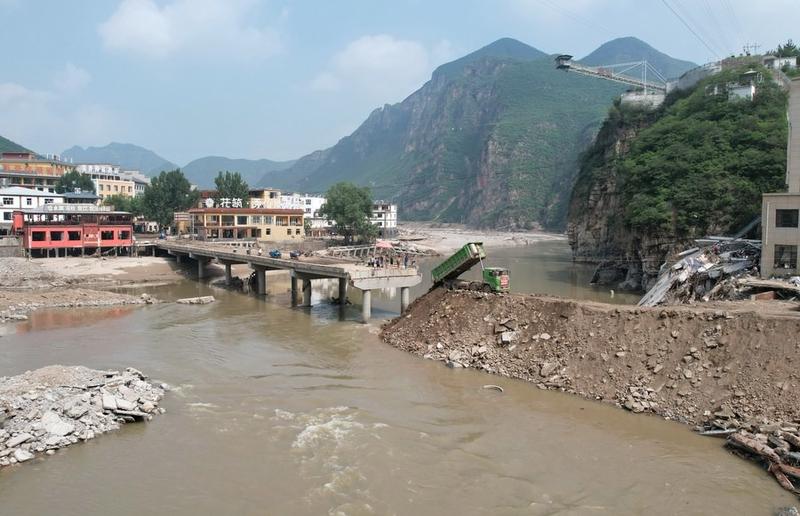 A staff member moves printed materials that had not been submerged by the flood at a printing company in Zhuozhou, Baoding, Hebei province on Aug 8, 2023. (PHOTO / VCG)
A staff member moves printed materials that had not been submerged by the flood at a printing company in Zhuozhou, Baoding, Hebei province on Aug 8, 2023. (PHOTO / VCG)
The National Financial Regulatory Administration has issued a circular requiring more efforts from the banking and insurance system to strengthen financial services for people and companies in the flood-hit regions.
Banks and insurance companies should fully support flood relief and reconstruction works in the regions. They must help ensure that people's life and business operations will be impacted by the natural disaster as minimally as possible through providing financial services in need, the administration said.
The regulator has also encouraged banks to develop special disaster relief credit products for market entities such as small and medium-sized enterprises, individual businesses, agricultural and breeding enterprises and farmers, and new agricultural business entities in the disaster-stricken areas
Banks and insurance companies should strengthen credit support for small and micro enterprises, individual businesses and rural residents, for infrastructure repairs and upgrades in key areas such as transportation, communications, gas and electricity, agricultural water conservancy, and flood control and prevention, it urged.
ALSO READ: Regulator asks industry to address insurance claims in flood-hit regions
They should well organize and mobilize emergency response to disasters, safeguard security of financial assets and important data, guarantee stable operation of basic financial services and key infrastructures, and contact clients proactively to provide efficient and targeted services, it said.
The regulator has also encouraged banks to develop special disaster relief credit products for market entities such as small and medium-sized enterprises, individual businesses, agricultural and breeding enterprises and farmers, and new agricultural business entities in the disaster-stricken areas.
READ MORE: SAR supports flood-hit areas in North China
Asking insurance institutions to actively participate in post-disaster recovery and reconstruction, the regulator said it would support insurance institutions to actively meet market entities' capital needs in the flood-stricken regions for post-disaster reconstruction and production recovery.
ALSO READ: China's State Council stresses work on flood relief, rebuilding
The NFRA also said it would guide insurance institutions to provide long-term funding support for key projects of water conservancy, infrastructure, and public services among others through insurance asset management products and private equity investment funds.
The regulator also urged its branches in the disaster-hit regions to strengthen coordination with relevant authorities and enhance emergency response mechanisms to better facilitate flood and disaster prevention and post-disaster economic recovery.
 This aerial photo taken on Aug 9, 2023 shows workers operating machinery to repair a bridge in Sanpo town, Laishui county, north China's Hebei province. (PHOTO / XINHUA)
This aerial photo taken on Aug 9, 2023 shows workers operating machinery to repair a bridge in Sanpo town, Laishui county, north China's Hebei province. (PHOTO / XINHUA)
Ensuring vegetable supply
China's agricultural authority has stepped up efforts to help the country's flood-ravaged regions minimize the impact on vegetable cultivation and ensure a stable supply.
Local authorities should promptly initiate drainage measures for flooded vegetable fields, and implement targeted measures to support autumn sowing, the Ministry of Agriculture and Rural Affairs said in a statement on its website Monday.
READ MORE: Civilian flood rescue teams need better coordination system
The ministry urged vegetable-producing areas in the country's southern provinces to increase vegetable growing on idle fields this winter, while asking those in northern regions to better use farming facilities such as greenhouses to increase the local supply of fresh vegetables.
It also urged efforts to monitor information about production, distribution and consumption of vegetables, and to publish market information in a timely manner.
The statement also urged agriculture departments at all levels to collaborate with relevant departments to ensure "green channels" for vehicles transporting fresh agricultural products to lower vegetable distribution costs and improve efficiency.
With Xinhua inputs


